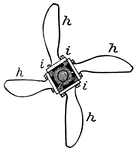
Screw Propeller, Sectional Elevation
"A propeller acting on the principle of the screw, attached to the exterior end of a shaft protruding…
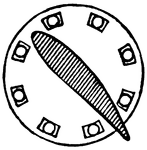
Screw Propeller, Cross Section of a Blade
"A propeller acting on the principle of the screw, attached to the exterior end of a shaft protruding…
Screw Propeller Ship, Diagrammatic View of the Hull
"A propeller acting on the principle of the screw, attached to the exterior end of a shaft protruding…

Semisagittate Mark
"In entomology, shaped like the longitudinal half of a barbed arrow-head, or like the barbed end of…
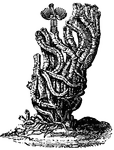
Calcareous Tubeworm (Serpula)
This worm is also called a fan worm, plume worm or red tube worm. "A Linnean genus of worms, subsequently…

Sofa with Two Settees
"A seat or bench of a particular form. A sofa; especially a sofa of peculiar pattern, as a short one…

Collection of Sewer Cross-Sections
"A conduit or canal constructed, especially in a town or city, to carry off superfluous, water, soil,…

Wheeler and Wilson Sewing Machine
"a, is the frame; b, shaft-crank which rocks the hook-shaft; e, receiving its motion from the double…

Detail of Wheeler and Wilson Sewing Machine
A detail of the Wheeler and Wilson Sewing Machine. "s, thread-leader; t, face-plate covering...; v,…
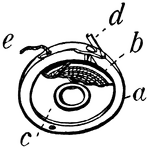
Bobbin Detail of Wheeler and Wilson Sewing Machine
"a is the bobbin case; c, bobbin; b, thread wound on bobbin; d, projection from bobbin-case which keeps…

Bobbin Detail of Wheeler and Wilson Sewing Machine
"a is the bobbin holder, partly opened to show hook b, and bobbin-case c; d, feed-points; e, presser-foot."…
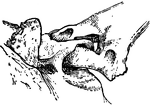
Shackle Joint from the Exoskeleton of a Siluroid Fish
"A joint involving the principle of the shackle. Specifically, in anatomy, a kind of articulation found…
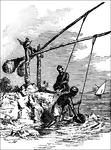
Shadoofs, Two Men Raising Water
"A contrivance extensively employed in Egypt and the East, generally for raising water. It consists…
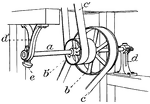
Shafting
"In machinery, the system of shafts which connects machinery with the prime mover, and through which…

Purchase Shears for Cutting Metal
A tool used for cutting metals. "a and c, levers connected by a link bar b, and respectively pivoted…
Ryegrass Leaf with Sheath
Lolium perenne. A sheath, in botany is "the part of an expanded organ that is rolled around a stem or…

Sheep's Foot Tool
"In printing, an iron hammer with a split curved claw at the end which serves for a handle. The claw…

Seven Shilling Piece from Great Britain
"...an English gold coin of the value of seven shillings, being the third part of the guinea, coined…
Shoe Block
"Nautically, a block with two sheaves, whose axes are at right angles to each other, used for the buntlines…

Short Cartridge - Copper Case
"A cartridge containing shot instead of a bullet, and intended to serve various purposes. a, copper…

Short Cartridge - Paper Case
"A cartridge containing shot instead of a bullet, and intended to serve various purposes. a, paper case…

Bones of the Shoulder and Upper Extremity - Front View
"A, acromion; C, coracoid; CA, carpus; CL, clavicle; H, humerus; M, metacarpals; O, ventral surface…
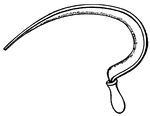
Sickle with Serrated Edge
"A reaping hook; a curved blade of steel (anciently also of bronze) having the edge on the inner side…
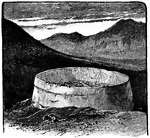
Tower of Silence Built by the Parsees
"A tower, generally built about 25 feet high, on which the Parsees expose the bodies of their dead to…

Silenus - Marble Sculpture
"In Greek mythology, a divinity of Asiatic origin, the foster-father of Bacchus, and leader of the satyrs,…

George Washington - Silhouette
A silhouette is "a profile portrait in black, so called after Etienne de Silhouette, French minister…
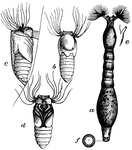
Fish-Killing Buffalo Gnat Larva
"They are small hump-backed gnats, of a gray or blackish color, with broad pale wings." —Whitney,…

Kobus Sing-Sing Antelope
"A West-African kob antelope, Kobus sing-sing. —Whitney, 1889 This illustration shows the antelope…

Iphigenia Brasiliensis - Sinupalliate Right Valve
"Having a sinuous pallial margin and consequent sinuous impression on the shell along the line of attachment…

Sinusoid or Sine Wave
"The curve of sines, in which the abscissas are proportional to an angle, and the ordinates to its sine."…
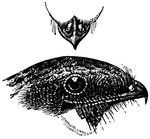
Nightjar Profile and Tubular Nostrils
Siphonorhis americana. "A genus of American Caprimulgidae or goatsuckers, having tubular nostrils. The…

Red Whelk
Fusus antiquus. "...a division of prosobranchiate gastropods, having the lip of the shell notched, canaliculate,…

Peanut Worm - Interior Anatomy of Adult
Sipunculus nudus. A species of unsegmented marine worm, commonly called the peanut worm. "A, One fourth…

Peanut Worm - Interior Anatomy of Larva
Sipunculus nudus. A species of unsegmented marine worm, commonly called the peanut worm. "B, Larval…
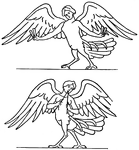
Sirens on a Greek Funeral Marble
"In Greek mythology, one of two, or three, or an indeterminate number of sea-nymphs who by their singing…
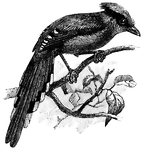
Sirgang
"The so-called green jackdaw of Asia, Cissa sinensis. The sirgang inhabits the southeastern Himalayan…

Siro Americanus
"The typical genus of Sironidae. Two species inhabit Europe, one the Philippines, and another (undescribed)…
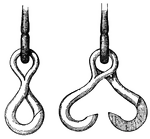
Sister Hooks - Closed and Open
"Nautical, one of a pair of hooks working on the same axis and fitting closely together: much used about…
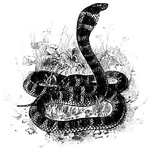
King Cobra
Illustration of a King cobra, Ophiophagus elaps, also called a Shiva snake or Siva snake because it…
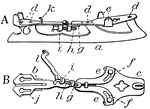
American Club Ice Skate - View from Side and Bottom
"A, side view of American club-skate; B, bottom of the skate with the runner removed. a, runner; b,…

Roller Skate - Side View
"A contrivance for enabling a person to glide swiftly on ice, consisting of a steel runner fixed either…
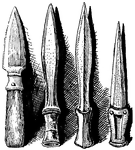
Skeans - Ancient Irish Daggers
"A dagger; specifically, an ancient form of dagger found Ireland, usually of bronze, double-edged, and…
Ski - Side and Bottom View
"A wooden runner, of tough wood, from five to ten feet long, an or an inch and a half thick at the middle,…

Skew Corbels
"In architecture, a stone built into the base of a gable to support the skews or coping above, and resist…
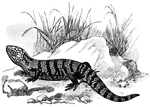
Skink, Giant Cyclodus
Cyclodus gigas. "They are harmless creatures, some inches long, natives mostly of warm countries, will…
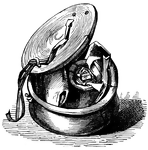
Skippet - Open Box with a Seal Inside
"A circular box used for covering and protecting a seal. Old documents were commonly sealed by means…
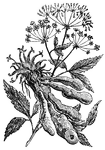
Skirret
Sium sisarum. "A species of water parsnip, generally said to be of Chinese origin, long cultivated in…

Skullcap - Upper Part of the Flowering Stem
"A plant of the genus Scutellaria: so called from the helmet-like appendage to the upper lip of the…
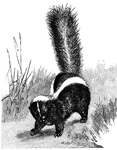
Common Skunk
"A fetid animal of the American genus Mephitis, M. mephitica... The animal inhabits all of temperate…
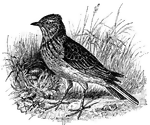
Skylark
"The common lark of Europe, Alauda arvensis: so called because it mounts toward the sky and sings as…
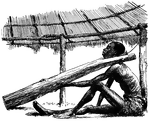
Slave Fork
"A forked branch of a tree, four or five feet long, used by slave-hunters in Africa to prevent the slaves…
Bobsled - Side View
"A pair of runners connected by a framework, used (sometimes with another pair) to carry loads or support…
Hand Sled
"A pair of runners connected by a framework, used (sometimes with another pair) to carry loads or support…

Hand Sled or Sledge
"1. A drag or dray without wheels, but mounted on runners, for the conveyance of loads over frozen snow…

A Woman in a Dress - 12th Century, with Long and Hanging Sleeves
"At different times during the middle ages extraordinarily long, pendant sleeves were in use, sometimes…

A Single-Horse Sleigh or Cutter
"A vehicle, mounted on runners, for transporting persons on the snow or ice; sled. a, runners; b, shoes;…
Sleeve Nut
"A double nut which has right-hand and left-hand threads for attaching the joint-ends of rods or tubes;…

Slice Tool in the Printing Trade
"In printing, a small spade-shaped iron tool with which printing ink is taken out of a tub and conveyed…
Slice Galley
"In printing, a galley with a false bottom, in the form of a thin slice of wood, which aids the removal…
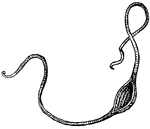
Sling
"An instrument for throwing stones or bullets, consisting of a strap and two strings attached to it.…